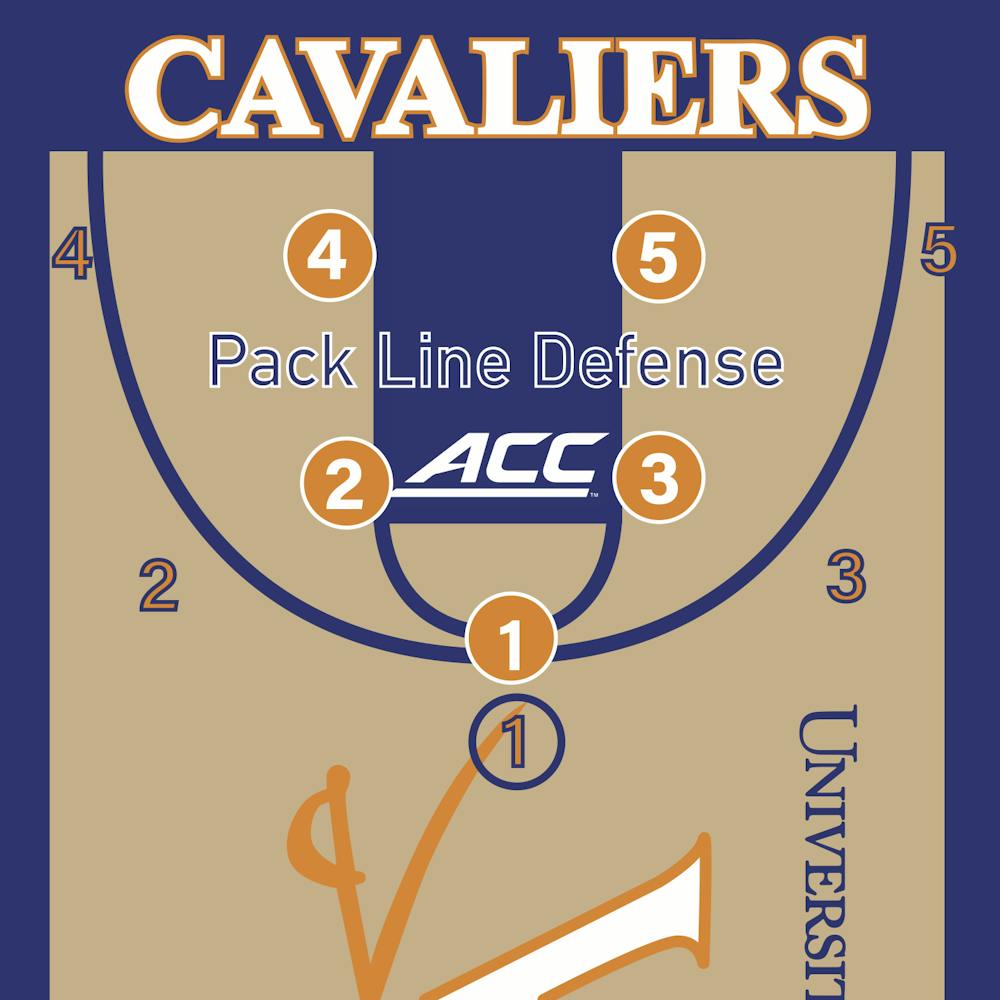Virginia’s men’s basketball team has had an unprecedented decade of success. In the last 10 years, the Cavaliers have appeared in all but one possible NCAA Tournament, won five ACC regular-season championships, a pair of ACC Tournaments and a National Championship. Those 10 years were more successful than the rest of the program’s history combined.
This elite span has coincided with the arrival of Coach Tony Bennett. Under Bennett, the Cavaliers have adopted deliberate and efficient approaches on both ends of the floor — the Pack Line defense and the Blocker-Mover offense.
The basics of these systems are well known to those who watch Virginia basketball. However, it’s worth diving into the nitty gritty of these systems to understand how the Cavaliers play and how they will look when their tournament starts Saturday.
The Pack Line Defense
Long before data science invaded NBA front offices and locker rooms, Tony’s father, Dick Bennett, realized the value of choking off the easiest and most efficient shot in basketball — shots close to the basket. At its core, the Pack Line’s job is to make sure those shots never occur.
The elder Bennett’s solution to this problem was to use one defender to hound the ball handler while the other four defenders hover in a tight arc on an imaginary line about six feet from the three-point line. This creates a wall which prevents offensive players from driving or cutting into the paint while still allowing the defenders to quickly transition to guarding a man or contesting a jumper. If an opponent gets the ball in the middle, then the four off-ball players all have license to crash the paint and wreak havoc.
The Pack Line has two main types of defenders — on-ball and off-ball. The on-ball defenders are often smaller, quicker players like junior guard Kihei Clark. The on-ball defender’s job is to funnel the ball into the teeth of the four defenders in the wall. When done well, this forces the attacker to either pass, throw up a bad shot or commit a turnover.
The off-ball defender’s job is a little more complex, but takes a lot less energy than hounding enemy guards. Their job is to wall off any attempt by the offense to move a person or the ball into the lane. They are also, however, secondarily responsible for helping one pass ahead — that means that the off-ball defenders are never really guarding a man, but the gaps between two men. This puts them in position to help instantly if another defender loses his assignment.
When one of those men gets the ball, the on-ball defender applies pressure, and an off-ball defender pulls a move called a stunt — a maneuver that allows the defender to appear as if they’re in two places at once. When the offensive player receives the ball, the help defender takes a jab step towards him to give the player the illusion that he is about to be double-teamed. This forces the offensive man to make a quick decision about how to get rid of the ball. The defender, though, drops back into a passing lane instead of fully committing to the double team.
The Pack Line is very strong against almost every type of offense. Its dependency on team cohesion means the whole team needs to have a bad night for the system to break down — someone is always in a position to help. It doesn’t require players to have elite physical gifts either, just a high basketball IQ. Most importantly, though, the Pack Line gets its strength from forcing teams to work especially hard to get efficient shots like three-pointers and layups.
The Pack Line has weaknesses, though. It is vulnerable to players who can get hot shooting from deep — think Syracuse junior guard Buddy Boeheim, who went 5-8 from three and nearly burned the Cavaliers in their last matchup, or Purdue junior guard Carsen Edwards’ 10-19 night that nearly bounced Virginia from the 2019 Elite Eight. Skilled playmakers like those two can also pass and dribble out of help and find open shooters with good skip passes that bypass off-ball defenders. Overall, though, the Pack Line is a very strong college defense that Virginia runs at an elite level.
The Blocker-Mover Offense
Like the Pack Line, the Blocker-Mover offense was developed by Dick Bennett in Wisconsin. Also like its defensive brother, it is very rarely used in the NBA — with only teams based around heavy ball movement daring to emulate it.
The basis of the Blocker-Mover is motion. Almost every single player is in constant motion, cutting, screening and passing in a circular motion in an attempt to create an open layup of three.
There are two types of players in the Blocker-Mover — blockers and movers. Movers are usually guards who are more focused on scoring and playmaking. They move around the court constantly, taking screens from blockers and attempting to create open looks for themselves and for teammates. For a good example of a mover, think Ty Jerome and Kyle Guy in 2019, flying around screens whipping the ball around the horn.
Blockers are generally bigger players who are more defensive-minded — the Jay Huffs and Jack Salts of the world. On offense, blockers are responsible for setting picks to open space for movers. If blockers are left open or someone shoots, the big boys have full license to crash the boards and grab easy points. If a smaller defender switches onto a bigger blocker, then the ballhandler can pinpoint that mismatch and find the big man down low for a post-up.
At the Blocker-Mover’s peak, the blockers and movers work in harmony on the Wheel play, a staple of the scheme. As a guard brings the ball up, the two blockers set their first picks — one flare screen at the top of the key and one pindown screen on the block. One mover cuts across the flare screen and moves from the wing to the corner vacated by the other mover, who motions across the baseline to the opposite corner. If either of those motions frees a player, the ball moves to them. If not, the blockers recycle their screens and the movers continue in a circle until someone finds an open shot.
The Cavalier offense doesn’t seem elite — they frequently grind out wins with fewer than 70 points scored. This is because the deliberate nature of Pack Line and Blocker-Mover slow down games to a glacial pace where possessions frequently use almost the whole shot clock. Despite its low-scoring games, Virginia consistently rates as a top-50 in efficiency via KenPom, clocking in at 11th this year. This is because the ball movement of the Blocker-Mover opens up late-clock layups and three-pointers like, well, clockwork.
The time-stretching nature of the Blocker-Mover is great for protecting leads, but it makes comebacks hard, especially if the other team is switching screens and playing cohesive team defense. That can lead to an endless series of screens and rescreens for 25 seconds, followed by a forced shot.
How Virginia will play in March
Virginia has only played one postseason game, winning a 72-69 thriller over Syracuse in the quarterfinals of the ACC Tournament. Unfortunately, that game seems to be a poor predictor of how Virginia will play other teams in the postseason.
Syracuse employed a 2-3 zone defense which also attempts to limit shots in the paint through team defense. The 2-3 zone is a great tactic to defend the Blocker-Mover offense because of the way it congests the areas where Virginia defenders like to cut and drive.
To counter this, Virginia used its base offense very little, opting instead to attempt to let a guard drive into the lane and then pass out to open shooters. This change in strategy may have been why the Cavaliers found themselves down as many as 11 points early, but it also worked perfectly to set up freshman guard Reece Beekman for his buzzer-beating three-pointer.
Virginia will face the 13th-seeded Ohio Bobcats (16-7, 9-5 MAC) in the tournament's first round Saturday in Indiana. Ohio entered the MAC tournament as a fifth-seed, but easily upset Kent State, Toledo and Buffalo to win the MAC’s automatic bid.
Ohio is no pushover. The Bobcats are led by junior guard Jason Preston, a top-scorer and legit NBA prospect who dropped 31 points the night that Ohio took No. 2 Illinois to the brink. Preston and co. play a solidly efficient offensive game, and their heliocentric style is exactly the type of system that can push the Pack Line to its limit. Ohio is a tough first-round matchup for the Cavaliers.
After the first round, Virginia faces a potential gauntlet — a tough Creighton team may await in the Second Round, and a Sweet 16 rematch seems imminent with the Gonzaga team that embarrassed the Cavaliers in December.
This bracket is a tough draw for Tony Bennett and his men. The team being quarantined until almost the night of their first game won’t make things easier. But we at least know how Virginia will attack its opponents when the time comes — with patience and ball movement on offense and a brick wall on defense.







